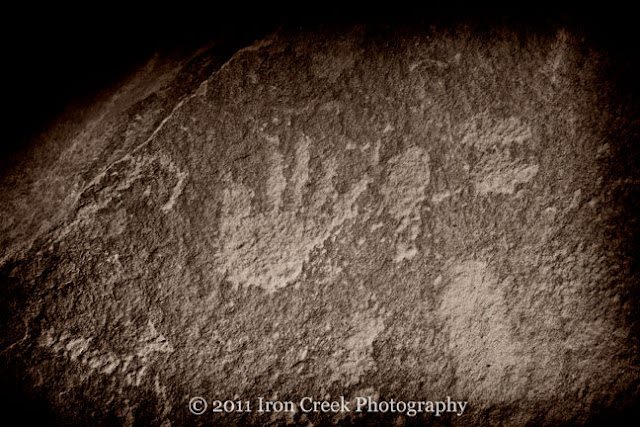Facing the ridge from the west you'll quickly see how it got its name - at least that's what Don has thought since first seeing it May 2004.
Comb Ridge is an immense sandstone formation tilted at an angle of about 20 degrees and just about 80 miles (128 km) long running north - south. Comb Wash and Butler Wash roads run on either side of the ridge and while we use the term "road" you need to remember you're out in the boonies.
Comb Ridge
Canon 1DsIII
EF 24-70 (24mm) f/8 1/125 ISO 100
Working along Comb Ridge
Canon 1DsIII
EF 24-70 (42mm) f/8 1/125 ISO 100
Comb Wash Road is on the west side connecting Routes 163 and 95 and is approximately 20 miles long. The road can be very sandy in spots, rocky, rutted in others and in some places all the above. We feel the best way to travel Comb Wash Road is in a high-clearance 4x4; if it's raining or just stopped raining you'll also need to consider mud - lots and lots of mud. This is one of those places we're glad to have both the high clearance and 4x4 as you'll need the high clearance for most of the road you'll also might need that 4x4 as well.
Canon 1DsIII
EF 24-70 (48mm) f/8 1/200 ISO100
EF 24-70 (48mm) f/8 1/200 ISO100
Leica M9
Summicron 50mm f/9.5 1/500 ISO 160
Remember you'll be in an area that has no water, no facilities and generally difficult access with not many people. What you will find is spectacular scenery which as landscape photographers just the place we like to be in.
Off Snow Flats Road
Canon 1DsIII
EF 24-70 (45mm) f/8 1/250 ISO 100
As previously reported, we traded our Jeep Rubicon in for a 2011 Ford F150 Raptor and wanted to take it out and see what it could do in rough country, thus the main purpose of the trip. We have been going through the small town of Bluff Utah since 2004 passing the Desert Rose Inn on our way to Moab
2011 Ford F150 Raptor
Canon 1DsIII
EF 24-70 (51mm) f/8 1/200 ISO 100
Looking over the shoulder
Leica M9
Summicron 50mm f/9.5 1/500 ISO 160
We left Tucson early Tuesday morning driving a scenic route north on Route 191 which took us passed the Hubbell Trading Post, through Chinle AZ and into Bluff UT all told approximately 420 miles. We arrived late afternoon with plenty of time to explore Comb Ridge prior to sunset.
This was Sandy's first time at Comb Ridge and we turned onto Comb Wash Road heading north off Route 163. Off the pavement and onto the red dirt that's found throughout this area. Comb Wash Road splits to the right and stays close to the base of the ridge while Snow Flats Road turns left and runs in a northwestern direction. We drove north crossing areas where water runs across the road in the wet season, driving down 3 to 4% grades on dirt, dusty road before coming around a corner and beginning the climb upwards. We drove past areas where tumble weeds were piled so high along the road we thought they were taller than the truck. We saw no-one on the road during the entire drive north to Route 95.
Tumble Weeds
Canon 1DsIII
EF 24-70 (24mm) f/8 1/200 ISO 100
The other side of the road
Canon 1DsIII
EF 24-70 (24mm) f/8 1/200 ISO 100
We still had a couple hours before sunset and neither of us had ever seen the eastern side of the ridge we decided to take Butler Wash Road south back towards Bluff. While we found the scenery not as appealing as the western side it does offer it's own unique scenery. The road is slightly better than Comb Wash Road and for the most part felt a non 4x4 could be safe here but as always you need to be careful.
We arrived in Bluff around 8 P.M. checked into the Desert Rose and got a good night's rest before heading out the following morning. The following morning we headed into the Valley of the Gods and Monument Valley for lunch at Goulding's Lodge & Trading Post before retuning to the west side of Comb Ridge where we spent the majority of the time. Returning to Comb Wash Road we decided to explore Snow Flats Road taking it to within 7-miles of Route 261 before turning around and going back to Comb Wash Road.
Canon 1DsIII
EF 24-70 (68mm) f/8 1/400 ISO 100
The area where we shot the pictographs that we shared in the previous post.
Sandy working
Leica M9
Summicon 50mm f/11 1/250 ISO 320
This is what Sandy was capturing
Canon 1DsIII
EF 24-70 (24mm) f/8 1/80 ISO 500
Don will be returning to the area in June for a couple of days and of course will be staying at the Desert Rose before heading west to Page and meeting with Ken Doo to shoot slot canyons in the area.
Our next post will be on Valley of the Gods which is right down the road so stay tuned.
Once again thank you for visiting and please remember your comments and questions are always welcome.
Sandy & Don
































































